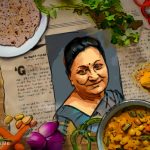The city where food breaks down divisions
Delhi’s food – from the street stall mo-mo to potato bread at the country’s best restaurant – stirs together what the ruling party seeks to divide: people across class, religion and caste.
Author:
22 November 2019

The litre of duty-free whisky was proving very useful. Not in blotting out saffron-coloured ethno-nationalism but in cleaning out the wounds inflicted by one of Delhi’s gated communities.
A hole through the sole of the foot needed swiftly applied medication and, at well after midnight, the 10-year-old Islay whisky was the only antiseptic at hand. So it was fed to the foot.
For the uninitiated (like this sorry traveller), many of the posher suburbs in India’s capital are subjected to lockdowns at around 11pm, when the large iron gates on the main thoroughfares into neighbourhoods are padlocked.
Sometimes they are manned by security guards. In other instances, interlopers must just figure a way out of the upper-middle-class goldfish bowl.
A drunken search for mo-mos (steamed dumplings) from the hipsterish Haus Kaz Village into Green Park had led to a familiar street stall and a full stomach, but also the anxious possibility of being caged in and experiencing a nocturnal stint on the area’s pavement.
Related article:
An autorickshaw driver who was bedding in for the night suggested walking two kilometres towards an exit point manned by security guards before doubling back around Green Park to return to the guesthouse in Haus Kaz Village.
A five-kilometre walk, the whisky-addled brain calculated.
Belligerence has always been the lesser part of valour, and an attempt to scale the spiked gate led only to a pierced shoe, a hole in the foot, and a bloody five kilometre hobble back home.
How we are divided
As the ruling Bharatiya Janata Party (BJP) seeks to create a homogenous, ethno-fascist version of India and “Indianness”, India’s divides with neighbouring countries are deepening – physically, economically, socially, bureaucratically and legislatively. These divides are also found within cities and between religions, classes and castes or those that separate outlier states, like Jammu and Kashmir in the north-west and Arunachal Pradesh, Manipur and Nagaland in the north-east.
The humble mo-mo, filled with chicken, paneer or vegetables, and costing around 80 Indian rupees (R17) for 10 pieces is sold in street stalls all over Delhi. They are testimony to the migratory instincts of humans with the dish said to have moved from neighbouring China, Tibet and Nepal into northern India, where it has become a street staple in cities from Delhi to Mumbai and Pune further south.

Some of those northern states – whose residents would have tasted mo-mos centuries before Indian nationalism – are now at the centre of the BJP’s push to separate “illegal immigrants” from “genuine Indians”.
The controversial six-year-old National Register of Citizens project – which demanded Indian citizens prove their nationality through inter-generational documentation – recently left out over two million names when published in the north-eastern state of Assam.
Many of those left “stateless”, “nationless” and facing the potential of being interned in camps or their families split up are from minorities, including the Muslim community.
What food brings together
Food, and its fusion into new communities, has always reinforced the dynamic nature of society and the idea that civilisation’s greatest achievements have emerged from movement. The evolution of what we eat owes as much to endeavour and exploration as it does to celebration and circumstance … or violence and bloodshed.
It was the trauma of Partition – which, at independence from British colonial rule, separated India and Pakistan in 1947 – that apparently brought the tandoor oven to Delhi, and led to the invention of murgh makhani or butter chicken. Or so the legend goes.
According to said legend, a young chef, Kundan Lal Gujral, who was working the tandoor ovens in a sweet shop in Peshawar (in what is today Pakistan), eventually bought the place from his ailing boss, renaming it Moti Mahal.
A Hindu, Gujral closed his Peshawar restaurant and relocated to Delhi at Partition. It was a journey that millions of others did, in one direction or the other, depending on one’s religion, sense of nationalism or fearfulness around personal and familial safety as communal rioting and murders escalated on the cusp of independence.

In Delhi, Gujral reopened Moti Mahal in Daryaganj, an area close to Old Delhi’s walled city which was founded in the 1600s by the Mughal emperor Shah Jahan when he relocated his court from Agra.
The newly installed Moti Mahal was where, one evening, scanning the drying out pieces of unsold chicken tikka hanging on seekhs above the tandoor, Gujral is reputed to have struck upon the idea of enlivening them with a sauce, rather than having to throw them away – or sell them tough the next day.
Gujral is said to have added butter, cream, tomatoes and additional spices to the tikka marinade to create a sauce that returned moisture to the unsold chicken when added, and a new curry was thus born.
Moti Mahal is proud of its history, and popularity among celebrities and politicians, especially in the 1950s when it attracted people including the Shah of Iran; India’s first prime minister, Jawaharlal Nehru; American president John F Kennedy and latterly, Indira Gandhi, the first woman prime minister of India. More recently, celebrity chef Gordon Ramsay filmed a cooking show in the restaurant’s kitchen.
Restaurant repast
Today, there is a faded glory about the place. The waiters veer between cloying attention to ghosting customers for long periods. The pink walls have the colour of fading flamingoes gasping for life in a drought and the bleakly suffocating plastic flowers suggest even their unnaturalness has not spared them the effects of Delhi’s dangerous pollution levels.
Families and hard drinkers nevertheless congregate around metal dishes groaning with meat from the tandoor oven and bowls of curry.
The butter chicken arrives dark red, spicy and with no hint of butter or cream. A few mouthfuls later it is confirmed that the wrong order was sent to the table: a murgh punjab da masala (440 rupees for a half-portion, which is more than adequate for one person) made with chopped masala, red chillies and coriander had arrived instead.
When the butter chicken (also 440 rupees for a half portion) does eventually land, it is luxurious, velvety and a more neon version of the Holland football jersey. It is sweeter than expected, with a tangy bite.

Both curries appear on the bill.
Which was fine, since there have been a few free-loaded meals on this journey, including the chef’s tasting menu (3 900 rupees) at Indian Accent.
Indian Accent’s head chef, Manish Mehrotra, is a friend of a dear friend of mine who lived in Delhi for several years. This connection means that, despite protestations, he refuses to present the bill when the six-course lunch tasting menu (plus a few chef’s surprise plates thrown in) finally ends a few hours into the early evening.
Among its many accolades, Indian Accent has won the San Pellegrino Best Restaurant Award in India by Asia’s 50 Best Restaurants 2019 for the sixth consecutive year and was featured this year in the World’s 50 Best Restaurants. It is widely considered the best restaurant in India, if not South Asia.
According to his website, Mehrotra “reinterprets nostalgic Indian dishes with an openness towards global techniques and influences”. He was instrumental in reinvigorating the South Asian restaurant scene with plating and presentation techniques.
So, instead of the communal eating and dishing out of bowls or pots, Mehrotra toys with size and texture in his cooking and its presentation, adding delicacy and insouciance to traditional Indian meals.
Related article:
One of the starters, for example, a puri aloo (potato bread) with sweet pumpkin and pickles finds the bread, which usually appears on tables across society as the size of one’s palm, shrunken yet puffed out to a size smaller than a golfball. Five of them appear on a plate like fragile miniature balloons on top of a circular bed of pickles to which a pool of pumpkin soup is added.
The main course of either roast chicken with a smoked papad curry or grilled sea bass with sweet potato and a Goan mango curry (added with a flourish to the plate), is accompanied by staples with a twist: a black dairy dal, a smoked eggplant raita, chilli hoisin duck kulcha with sesame butter and pearl millet roti with fresh hand-churned butter.
Close to the centre of Delhi, Indian Accent is based at the Lodhi Hotel, which is a regular haunt for politicians, power brokers, dealmakers and breakers.
At old Delhi’s heart
Indian Accent’s quietly refined air is a planet away from Chandni Chowk, which is one of the teeming hearts of Old Delhi and close to the Red Fort, built in 1639 by Shah Jahan and the official residence of the Mughal emperors until their dynastic demise.
On 15 August 1947, Nehru raised the Indian tricolore over the fort’s Lahori Gate to announce the birth of a new nation.
Chandni Chowk’s narrow lanes are filled with a swarm of humanity, which move like streams through the area. Sometimes, the human currents are relentless, pushing one along with a momentum of locals, wedding shoppers, tourists and delivery men on autorickshaws and bicycles. It is easier to give oneself to the slipstream than it is to resist it.
Among the claustrophobic alleyways is Paranthe Wali Gali or Paratha Alley, where canteens sell paratha bread with fillings including coriander, chilli, cashew nuts and almonds.

At the Gaya Prasad Shiv Garan, which has been around for six generations, men sit cross-legged next to ovens, pounding and shaping dough and making the parathas (50 to 70 rupees each) to order while no-nonsense waiters efficiently take orders from communal tables and top up steel thali plates from pails of food at the behest of customers.
Office workers and businessmen sit next to families out shopping and workers grabbing a quick bite before getting back to their manual labour.
Here, borders – of class and caste, of religion and race – appear of less consequence. But Delhi remains a city of migrants and empires replacing empires, of the blood of birth and death, and the grandness of change.
It is a place to savour both humanity’s contradictions and the words of the Kashmiri poet Agha Shahid Ali:
Swallow this summer street,
then wait for the monsoon.
Needless of rain
melt on the tongue. Will you go
farther?
A memory of droughtholds you:
you remember
the taste of hungry words
and you chew syllables of salt.
Can you rinse away this city that lasts
like blood on the bitten tongue?



